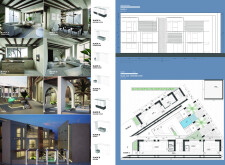5 key facts about this project
# Eco-Blade: Sustainable Modular Living
## Overview
Eco-Blade is an architectural design that integrates flexibility, sustainability, and modularity to address contemporary housing challenges. Located in a context conducive to harnessing natural resources, the design emphasizes the creation of functional living spaces while minimizing environmental impact. The project aims to serve as a prototype for future developments in sustainable architecture, focusing on adaptability to various user needs and environmental conditions.
## Spatial Strategy
The Eco-Blade design employs a series of interlocking modular units, referred to as “blades,” allowing for both independent functionality and larger combined living spaces. This spatial strategy is informed by environmental factors such as wind direction and natural light, enhancing energy efficiency and comfort. Each unit is equipped with features such as a comprehensive natural ventilation system to promote airflow, reducing reliance on mechanical cooling methods and supporting a more sustainable living environment. Internal spaces are structured to maximize usability, incorporating designated areas for living, cooking, and personal retreats.
## Materiality and Structural Design
A diverse selection of materials underpins the project, balancing durability with ecological consideration. The use of concrete blocks ensures structural integrity, while wood finishes provide warmth. Insulation materials promote energy efficiency, and large glass windows facilitate natural light penetration. The metal framework supports complex configurations while maintaining overall strength. The design is broken down into construction blocks, including foundations, structural beams, and defined ceiling and flooring elements that contribute both to aesthetic appeal and thermal performance.
Each of these components has been thoughtfully designed to enhance the user experience, offering customizable configurations that cater to the needs of modern families. The emphasis on sustainable materials not only contributes to the longevity of the structure but also aligns with ongoing operational expense reduction strategies through energy efficiency measures.

























































